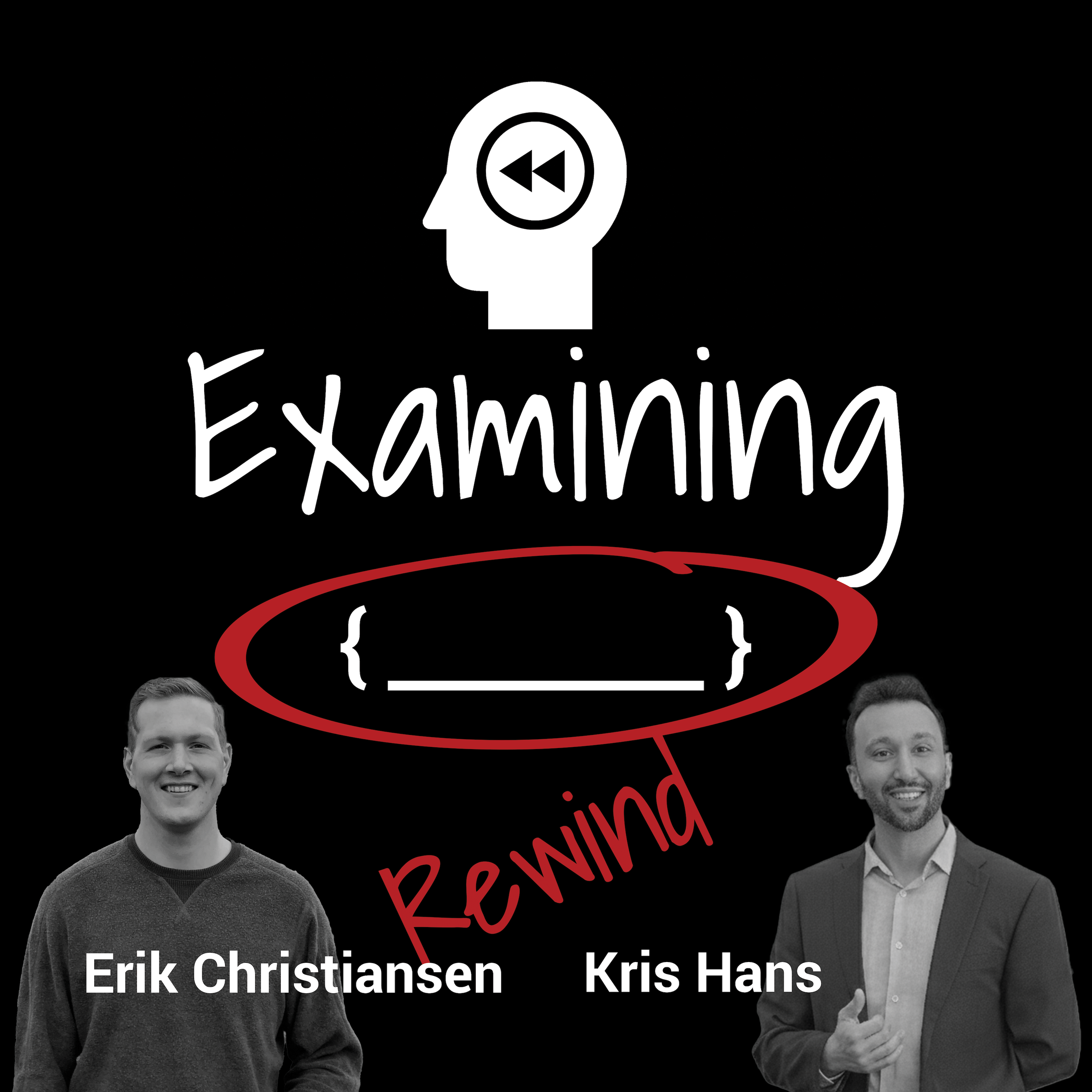Episode Transcript
[00:00:08] Speaker A: Welcome to Examining a technology focused podcast that dives deep.
I'm Eric Christensen.
[00:00:16] Speaker B: And I'm Chris Haunt.
[00:00:23] Speaker A: And welcome to another episode of Examining the technology focused podcast that dives deep. Good afternoon, Chris. How are you this afternoon?
[00:00:33] Speaker B: Good afternoon. Yeah, I'm doing well.
[00:00:36] Speaker A: Yeah.
[00:00:36] Speaker B: How about you?
[00:00:38] Speaker A: I'm well, I mean, it's been kind of a little bit of a whirlwind.
Earlier this month I was at a conference in Ottawa. I was at can ux, also pronounced Canucks, which is kind of.
I don't know if it's the only. But it's certainly one of the premier kind of user experience design conferences in Canada. I'd never been. It was really, really interesting.
Some people from. With my background, a lot of people with very different backgrounds.
It's always really interesting to network with people who do service design and UI design and just how they came or user research and how they came to that field. It's certainly fascinating. Of course, some people come from the design side, industrial design and otherwise, but other people, a lot of people from communications or like a MLAS background. It's just interesting to see the different educational backgrounds that are applicable to that particular field.
But some really great speakers. So I don't know if I've already said I'm a little loopy today, but that was in Ottawa and then I was back and then I had lots of instruction and then we were away for the long Thanksgiving weekend.
So in between last time we recorded, of course we released a rewind episode, but that kind of one of our classics on a world without email.
But we're kind of back to form now. What have you been up to?
[00:02:16] Speaker B: Just I got some deadlines, gotta get certain things submitted and so on. But yeah, I mean, it's.
Even though it's like a break, it isn't really a break because we've got work to do. So.
[00:02:29] Speaker A: Yeah.
[00:02:30] Speaker B: But yeah, it's nice spending time with the family.
So.
[00:02:36] Speaker A: Yeah, it always feels good to kind of slow down, even if you do have to do work or reduce that. The frequency or the places you have to go.
I think our episode today is pretty straightforward.
You know, maybe we just start talking about what is top of mind for everybody, which is more AI. That seems to be AI Everywhere. AI. AI. AI. More AI.
I actually had trouble choosing stories today because there's another hard. There's a hardware thing that I want to talk about, but I don't.
[00:03:09] Speaker B: I don't.
[00:03:09] Speaker A: I don't know enough about it. It's from Nvidia and Dell to really comment on it, that little AI box. So maybe we'll talk about it another time. But I think the thing that we probably have to talk about is the Sora AI Video generator. So AI imagery, AI text, AI video.
So what is Sora?
[00:03:33] Speaker B: So I mean, Sora. It's OpenAI's.
It's. I don't know even how to describe because it, it's like, almost like they've created like this little tick tock app. So for those that are, you know, already have subscriptions to Open AI it was first released to the pro users and then to the plus and so but it spits out shockingly believable videos with synced audio and it's pretty quick. It's.
I like how it's, you know, trying to respect the, the creators and the viewers by putting in, you know, the watermarking and so on.
[00:04:14] Speaker A: It's.
[00:04:15] Speaker B: It's basically you can go from text to video and you know, I, I don't know what the idea is be behind this. I mean you can go and share the videos using that app. And again, it's like this, it's almost like a, a tick tock kind of app. And there's weird things on there.
You initially when you started off, you go and create a cameo. And so even that process, it's, you know, you just read off three numbers. You let it take some pictures of you with your, you know, front face, then you turn either to the right or the left, whatever it prompts you and then looks up.
And based off of that, it will take that imagery and incorporate it if you'd like to. In terms of that cameo.
[00:05:09] Speaker A: And this is.
I'm not as familiar or as well versed on the video creation platforms. I mean this is one of the front runners.
Does Google have a front runner for video creation as well?
[00:05:24] Speaker B: I believe there, well, there's. That banana was a nano banana that creates the images. And I'm not sure if I think they are creating something for that. Probably the, the leading one is. Isn't it Mid Journey?
[00:05:38] Speaker A: Mid Journey, yeah. Which, which is. Yeah, is one. And then I think there's Google VO is and so the Mid Journey. There's also Runway. I haven't heard. I don't know.
I don't really know how Runway works. I'm not as familiar with it.
But again, it's another, you know, text to video creation.
So, you know, there's a, there's a tight race for all of these.
[00:06:06] Speaker B: It.
[00:06:06] Speaker A: From what I've seen so far, I haven't seen as many from VEO. I think it's probably because OpenAI has this name recognition, so there's so many people that immediately flock to their stuff, whether it's the best or not.
But.
And today you and I were discussing should we talk about the news coverage around this? And maybe we'll do that as it starts to come out, because I think it's just, we need some time to process it, but our own impressions are that it's pretty impressive.
So just as an example, I guess I could share them in the show notes, the ones that I created.
[00:06:45] Speaker B: Okay, yeah, that's true.
[00:06:46] Speaker A: I think so. So two of them turned out kind of as I wanted and one of them didn'.
So now you had a great suggestion, which is to get OpenAI's ChatGPT to help me with the prompts, which is a really good idea. And I didn't think about that. So I just was like, what's the.
When I first go to Sora, there's all these videos that have been created and I think what people are doing is that they're taking one, adding new instructions to remix it and then building upon it. Because there's just like this infinite scrolling list of either the clown from it, people knocking at the door while there's a tornado outside, there's all this stuff of the queen at barbecues and random events. So it's a lot of remixing of videos that have been already posted. So I wanted to create something from scratch.
So one of them was a frustrated college student stands up in class, lifts his laptop over his head and slams it down on the table, turning the laptop into pixie dust. The student disappears into a puff of smoke.
You saw that?
I think that worked pretty much. I mean, that's pretty much exactly what it was. It was very realistic. I can't take this anymore. He slaps his laptop down, there's pixie dust goes everywhere. He didn't totally disappear, he just kind of smoke comes out. It looks like it comes out of the computer. Maybe because he damaged it, maybe the video the AI didn't understand. But pretty realistic was the other one that I tried. I said a middle aged man uses a ballpoint pen as a wand wand to summon an army of ladybugs.
And what's interesting about this is that I just expected.
I don't know what I expected. I just, I expected, you know, like middle aged man in a white room shooting ladybugs out of a wand. I didn't expect much, but it adds other stuff, right? Like he's in a forest.
The gentleman himself looks super realistic. He's in a forested background with kind of like a blurred background effect. It looks like he's in a real forest. The ballpoint pen is like glowing as he kind of draws across the screen. It has a very kind of Disney esque or LucasArts esque effect.
The ladybugs fly out of him towards the camera, kind of off angle. He's speaking some sort of magic words which I didn't tell it to do. So I'm kind of surprised how much liberty it takes with what you put in versus what comes out.
It seems more of a jump from say what's generated through text.
[00:09:21] Speaker B: Yeah. And also just, you know, for everybody, this is Sora too. So you know, OpenAI did have Sora 1 and this would be, I would say it's a big leap over the first one. It has better physics, better control, has the synchronized audio and then it has the standalone app. Apparently the API is coming as well. But on, on the surface the tech is pretty impressive. There's some pretty slick demos that if you want to go and take a look a lot it was with Sam Altman going and he was one of the co founders of OpenAI. But I do like, I mean I just started experimenting just today with it and I, I didn't know how it would work. I thought maybe you could throw some images. It actually didn't let me. I took some images of us went to ax throwing and I took some images. It wouldn't let it actually stop me from doing it. And I guess the default doesn't allow you to just take somebody's IM image and throw it in there and then what you can do is go and use cameos.
And so even that I, I wasn't, it took me a bit of experimentation to go and figure that out. But I think, you know, if, if OpenAI if you know the fact that they have some of these guardrails, if they could go and I mean it is watermarked so you know, the, at least from that aspect you can maybe prevent some deep fake kind of action going on. But I mean if they could put in together some sort of traceable output having predictable limits and not just because the regulators, regulators say so, but because, you know, this is. The customers deserve some sort of clarity.
So you know, that way that you could have some honest provenance. So where this clip was generated by whom, where, you know, and then that way you could actually go and check and find where this was actually created. And then also in terms of the training data and the likeness. You know how. How that all applies? I. I haven't even looked at the terms and conditions of all this, so. Anyways. But yeah, it is.
Right now it's by invite only, so they're slowly trying to get people on board and then that broader API access will come later.
[00:11:59] Speaker A: Just as a question, are you using your laptop mic or the mic in front of you?
[00:12:09] Speaker B: I should be. Let me check. I don't know.
Why is it off?
[00:12:14] Speaker A: Just sound different.
[00:12:16] Speaker B: Let me check.
Oh, it is. Yeah. It's using my. That's weird.
[00:12:22] Speaker A: It doesn't matter. It still sounded pretty good.
[00:12:25] Speaker B: How about my. Is that better?
[00:12:27] Speaker A: That's much better.
[00:12:29] Speaker B: I don't know. My laptop's far away from me, so it's okay.
[00:12:32] Speaker A: I'm going to leave all this in too. That you had to change your mic because it's easier to edit.
It happens to me. I've done this in the past. It's not a big deal. And you have a much better mic than me, so it makes more of a difference.
Um, so it's invite only. Um, I'm temporarily at least, not a chatgpt plus subscriber.
No offense to OpenAI. I'm not saying I didn't get any value from it. Um, I think it's because lately I've been doing a lot of things where I don't really. I haven't been using it.
Um, so just for the time being, at the very least, there's no sense of paying for something that I'm not using.
Um, but. So do you get Sora access as part of plus?
[00:13:13] Speaker B: Yeah. Yeah. So, like, initially when I tried, I didn't have access. And so that was a little while ago, maybe like a week and a half or so so ago. And then I just randomly. I opened it up just to see if I have access and. And I. I did. It just. It worked.
[00:13:29] Speaker A: I used the old one in the past, I think I feel like I used Sora one.
[00:13:34] Speaker B: Yeah, I. I don't think I ever used Sora one. But anyways, at the end of it, I had some invite codes, so I gave one to you and I gave some to some of my family. We'll see if they use it or not.
I just sent you like earlier. I don't think I'm going to share this, but I just thought I'd see how well it does in terms of when you actually use your cameo. And so I just put myself in a TED Talk. And I mean, my likeness was pretty good, but it's very good. The voice was. The voice was off.
[00:14:07] Speaker A: Yeah, the voice is wonky. That's the. I agree. And so.
[00:14:13] Speaker B: Yeah, and then it was funny too. Like even with the ax throwing that I told you about. So the images that we.
I just had chat GPT create some, you know, prompts to. And I took the pictures that we took from the, the ax throwing and how to generate like a description. And the first one, it was just weird. Like I did three videos.
One had, you know, it went and created like somebody who's Asian and then I don't even know what the other person would have been. It was, you know, a picture of my sister in law and her husband. And then the second one, it was Caucasian. So then I thought, okay, the third one I'll go and actually describe their ethnicity. And then when I put that in it actually, for whatever reason, I don't know if this is like a bias or what have you, but it actually made them somewhat.
A little bit overweight. And I'm like, okay, this is kind of interesting. So but anyways, and the, the first two like the, they were kind of jacked and fit and so yeah, it was kind of weird.
[00:15:16] Speaker A: Yeah, I'd be, I understand a little bit better how the, the models work from the text side but it'd be really interesting to see if, just to understand a bit more the technicals of how it generates this video. Like does it take clips of videos it's found and like map over top of what it like something that's.
It's pretty incredible.
Yeah. I don't know what to say about it. I mean, I guess perhaps what we should talk about is where it could be useful and where people are concerned.
So misinformation is a concern now like you said, these are watermarked.
They're kind of in a. It's almost like a social sharing app. It's not really designed, of course you can download them, but it's not really designed to be.
It's limited I suppose is what I'm trying to say in terms of how long you can make them and a bunch of stuff. But you are essentially using a fake.
It's not reality. Right. So there is some concerns about misinformation and it does remind me of an earlier time. I mean I remember it was a family member had sent me a video of like a plane landing, doing some crazy recovery and then landing successfully. And to me this is like maybe 15 years ago to me. The video was obviously computer generated.
It didn't look real, but they thought it was real.
And so, I don't know, moving forward, if people will be able to develop the same sort of sixth sense, for lack of a better word, on what is a fake and what is real, since this is so much better.
[00:17:09] Speaker B: Yeah, yeah, exactly.
[00:17:13] Speaker A: Do we see just like a proliferation of misinformation now?
[00:17:18] Speaker B: Well, and that again, who knows, right? Like, Like, I don't have TikTok, but some, some of my family, they sent a video and then I'm like, hey, I don't. Guys, I don't have TikTok. So what, what did you send over to me anyways? And then they're like, oh, yeah, it was Katy Perry and Justin Trudeau. And I'm like, oh, okay. Well, then I actually downloaded it just to see. And I mean, who knows? Like this, it could be something where you. You go and have somebody that. It looks pretty realistic, right? I mean, I. I know a guy that is pretty successful and he's been going and using SORA too, like crazy. And, you know, just recording little videos about, you know, fintech and blockchain and other things and probably puts in the script or what have you. And if I didn't look for that SORA watermark, because it's. It's not like it's there, it's like floats around or what have you. I mean, at first glance, I would actually think, oh, well, maybe he's actually doing this talk.
[00:18:21] Speaker A: You could edit it out, theoretically. I mean, if it's on the periphery of the video, you could put it in Premiere and you could add. You could crop it and you could edit it out.
[00:18:30] Speaker B: Yeah, there you go. And so then, yeah, I don't know. I mean, it could definitely cause some issues.
And these days, especially from the news media, it's almost like, you know, you want to get things out first and fast.
So how many people are going to go and do their fact checking?
[00:18:50] Speaker A: Yeah, I see from like an automation perspective, people who do social media marketing and people who do, like sets just must be. Terrible fight.
[00:19:03] Speaker B: Yeah, I mean, I, I saw something just even. Where was it here. I took some notes on this.
Somebody was saying, like, just with the agency side, you know, those that are in the marketing side of things, like, it's. Who knows? I mean, we probably don't have much time left in terms of coming up with, especially with all the AI tools and so, you know, and then clients, they would likely be bringing in a lot of their work in house and with the help of this AI tooling. And so, you know, now agencies they're, they're losing their pitches.
And so what you would have to do, especially when you got things like Mid Journey, Sora 2 Nano, Banana Chat, GPT5 and then on top of it you got all these other like, you know, quad code and cursor and things. It's, it's getting really tough. And so I think for those in that particular industry, you would have to go and focus in on and double down on an actual genuine strategy as opposed to a lot of this traditional model of what you would have. Because a lot of those things, the production side, it can be replicated now with AI.
[00:20:21] Speaker A: Yeah, yeah, that's what I'm thinking. I mean, I don't think it's at the level where you can do, you know, generate a commercial, four minute commercial or you know what I mean? Like there's certain things that need to be scripted and acted and staged properly, but especially for quick content on social or.
Yeah, I'm thinking that kind of reels content.
This seems like an absolute game changer.
I may even thinking now about we don't have a marketing department. I mean and we're the marketing department for our podcast. So what could we do with our logo or back to make background images or shorts or you know, and then without making it look fake like even just like abstract images or. I'm always thinking of things like that, you know, this is, this is kind of a game changer.
[00:21:11] Speaker B: Yeah. But again this is where like, I mean when I say in terms of strategy, like I saw something recently where doordash, they were activating. So they. I don't know if you saw this on social media, but there was a gentleman that was in, he's watching a soccer game live and you know, he just kept getting doordash stuff. Right. And it wasn't like blatant like he had a doordash bag at the bottom, but because he was doing so many weird things like he had this big chip and he's eating that. Then he gets like a meal like, you know, and they set down a little table for him with where he's eating pasta and then the guy next to him, he actually let him have like a bite first or what have you. And, and so like, I mean that's, that's pretty cool when you got all of the people in the stadium going and looking at this and then they're sharing those videos with other people.
Right. It's kind of like even like that Coldplay concert where you know, Gwyneth Paltrow afterwards helped with that company, the tech company.
And so again, like these are things that you again, you got to think about from a public relations and you know, that social media marketing type of lens and think about the strategy of how you could engage people online.
And so, yeah, I don't know, but it certainly, I think, certainly makes things different for people who are smaller organizations and what they could go and accomplish with that.
[00:22:40] Speaker A: Well, I don't. We'll keep reporting on this as we play more with it and talk about it, but it's pretty incredible. I thought maybe I might want to switch gears to a slightly different story and then perhaps just remind people what they can do with regards to privacy. There was a really interesting article in Wired. I think you might have to be a subscriber to read it, though I did send it to you. And essentially what happened is that it's called Satellites are leaking the World Secrets Calls, texts, military and corporate data.
And then the sub headline is with just $800 in basic equipment, researchers found a stunning variety of data, including thousands of mobile users, calls and texts, and even US military communications sent by satellites unencrypted.
So this was done through so that there's an interesting kind of preamble here. So it says roughly half of geostationary satell, many carrying sensitive customer corporate and government communications, have been left entirely vulnerable to eavesdropping. A team of researchers at University of California San Diego and the University of Maryland revealed today in a study. And then the article from Wired links to the study that will likely resonate across cybersecurity industry, telecom firms inside the military and intelligence networks. And so for three years these two schools have been using kind of like roughly $800 to $1,000 worth of off the shelf equipment. So like a satellite receiver on the roof of the university building in Loyola Seaside neighborhood of San Diego to pick up the communications of geosynchronous satellites in the small band of space visible from their Southern California vantage point.
And by simply and then the article goes on to say by simply pointing their dish at different satellites and spending months interpreting the obscure but unprotected signals they received from them, the researchers assembled alarming collection of private data. So they obtained samples of the contents of Americans calls and text messages on T mobile cellular network data from airline passengers and in flight WI fi browsing communications to and from critical infrastructure. So like electricity, offshore oil and gas platforms, and even US and Mexican military and law enforcement communications.
So what's interesting is that I guess what happens with a lot of data, customer data, so if you're using a cell phone between cellular towers, that stuff does get encrypted by the providers. But I think the problem is that when you're in a remote area, my understanding is that these satellites kind of bridge that gap when the satellite tower, or, sorry, the cellular towers are really far away from each other. So then the satellite is like the bridge between towers and distant places. So big desert regions, mountainous regions that don't require as much coverage because there's not as many people there.
They're more likely to rely on satellites to kind of relay the information between the cellular towers. And it's in that area that we get a lot of basically unencrypted information.
[00:26:21] Speaker B: And it's funny because it's the, really, the biggest security hole here. It isn't hidden in its code. It's just floating above us, literally. Right? So they didn't hack, they didn't breach, it's just open. This isn't some sort of sophisticated cyber attack. It's just laziness.
I don't know, at like an orbital scale. And so, you know, I think the big flawed assumption is that with the satellite industry that it's been operating on is that no one's ever going to check.
[00:26:53] Speaker A: Yeah, and you make a great, you make a great point that no one's going to check. So they say in here that the phone calls and text messages the researchers obtained in particular were exposed due to the telecoms often overlooked use of satellite communications for offering cellular coverage to normal phone users who connect to cell towers in remote locations.
So what did they say here? Some towers in desert mountain areas, yada, yada, yada, connect a satellite that relays their signals to and from the rest of the telecom's core cellular network, the internal communications of the network known as backhaul traffic. And so the people just say that. I guess they never thought that anybody would really look that closely. So when we saw this, my first question was, did we just commit a felony? But they weren't like harvesting, they were just passively listening to information.
But I think what's striking is that they didn't have a very big budget to do this.
Right?
I mean, then they also obtained communications from Mexican military and law enforcement for like, narcotics trafficking, maintenance records for aircrafts like the Mil 17 and, uh, 60, Blackhawk helicopters, sea vessels, armored vehicles. So I mean, it's not like they have a perfect transcript, all this content, but they, they can get like snapshots, like little bits of it.
And so I think it highlights how important it Is.
Well, I mean at the end of the article they compare their study's revelation, the sheer scale of unprotected satellite data for the taking, to some of the revelations 10 or so years ago from Edward Snowden that showed how the NSA and Britain's channel gchq we're able to obtain telecom and Internet data at an enormous scale. And so we have this vision a lot of the time that there's these back doors put everywhere. And maybe that's true, but it wasn't even necessary. This is just open.
And so it kind of highlights I think to our listeners and people in general how seriously they have to take sending their information and how. And I thought maybe we could, you know, spend a little bit of time talking about maybe what we do to protect that.
[00:29:23] Speaker B: Yeah, no, for sure. But yeah, I mean I think it is kind of. It's really interesting because look at if we spent decades obsessing over like firewalls and two factor authentication, but here it's just literally nobody thought to encrypt the radio waves bouncing between satellites and Earth.
[00:29:39] Speaker A: Yeah. And now part of this is like mitigated by the tools that we use.
So I'm assuming that what they were able intercept is largely text messages like SMS or whatever the new version of that is.
I can't remember the acronym but like message. So textual messages sent over the cellular network. I'm assuming that's a little bit different than messaging applications like imessage or signal.
So that's using data and I think that's, you know. So if you're using imessage between iPhone users, presumably that would be encrypted end to end. So if I send you a message, it's encrypted until you receive it kind of a thing. I don't, I don't know that. I think they could probably intercept some of the data but it would look like gobbledygook. It wouldn't be very helpful. Right.
So one of the reasons why I try not to send SMS messages or whatever the new. I'm trying to remember what was the.
Remember there was this big hoopla about SMS and then Apple not supporting the successor to that. What was that called?
[00:30:50] Speaker B: Well now they have, haven't they?
[00:30:52] Speaker A: They have, but I don't remember the name of it. What is it called?
[00:30:55] Speaker B: Was it mms?
[00:30:57] Speaker A: No.
[00:30:57] Speaker B: Multimedia maybe.
Or rcs.
[00:31:00] Speaker A: Rcs. So Rich Communication Service or whatever it's called. So RCS allows like Apple and Android users to use the cellular network to send like read receipts and to see Stuff like that. Right. Things that you would expect typically only with an imessage. So they've accepted that. But that would go through the cell network.
So I believe that would be if it was done through a satellite for that backhaul traffic that would be somewhat unencrypted. So one solution people can have, I know in Europe is that they, you know, you ask for somebody's phone number, but it usually just connects to their WhatsApp. Not that I trust WhatsApp security at all. So using something like imessage or signal would probably be a good way to ensure that you're using data that's encrypted end to end.
Same thing with like audio. Right. Like something done through FaceTime or teams formerly known as Skype is probably more secure than using just audio over the cellular network.
[00:32:06] Speaker B: Yeah. And this is where again, I mean, I think you should just be careful with, if you're going in relaying any kind of sensitive data with anybody digital, you know, I don't know. I think people, a lot of times, they just take like this carefree attitude towards digital and not really think of it. But it could conceivably last forever.
[00:32:28] Speaker A: Yeah. So who knows what Chris and I have messaged each other, that's out there forever.
But we're using a messaging platform. We're probably not using a cellular network, so interesting story.
Maybe we use a messaging app.
Invest perhaps in a VPN service if you're setting things like that.
So at least your Internet service provider. And I think it raises a bigger issue about who can actually see this stuff. Right. I mean, your Internet service provide or can see your web traffic. A lot of, a lot of companies can.
So just encrypting that by default, even if it does take a hit to your network speeds or your battery life is probably worth it.
[00:33:11] Speaker B: Yeah, yeah, exactly. Let's see. This is where again, I, I don't know, I was thinking like everybody is looking at innovation in space and what we really need is just some more common sense on earth.
So.
[00:33:26] Speaker A: Yeah, if only it were that simple.
Well, that's probably a good place. I don't know. I can't think of a better place to end it than that. Common sense on Earth.
So we'll have to touch base next time and we'll see if we have more to report on these topics.
[00:33:44] Speaker B: That sounds good.
[00:33:45] Speaker A: Okay, take care.
[00:33:47] Speaker B: Yeah, you.






